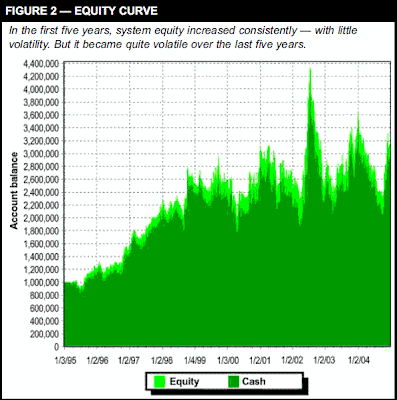System concept
Many trend-following systems use breakout channels that track high and low levels over certain look-back periods (e.g., 20 days) to determine trends. Once price crosses above or below the channel price, these systems enter the market in the breakout direction. However, because many trend followers enter the market when price exceeds these levels, it’s difficult to get a good fill.This system narrows the breakout channel a bit to place trades before other traders do. Instead of waiting for price to cross its highest or lowest points over the last 20 days, this system enters at the second highest or lowest level. The system uses two indicators called HighestN and LowestN that return the nth highest or lowest price within any look-back period (these indicators are available free at www.Wealth-Lab.com).
 Figure 1 shows several trade signals in the Euro FX futures (EC). The system held a short position on May 26, 2000 before reversing and going long once price crossed above the upper boundary of the second highest channel. Then, it exited and went short on July 13 after price crossed below its lower band — a 1.3- point gain.
Figure 1 shows several trade signals in the Euro FX futures (EC). The system held a short position on May 26, 2000 before reversing and going long once price crossed above the upper boundary of the second highest channel. Then, it exited and went short on July 13 after price crossed below its lower band — a 1.3- point gain.The system held this short trade until Nov. 30, when it reversed again as price penetrated the upper channel — a 7-point profit. This final long trade exited on Jan. 24 with a 5.2-point profit. Each trade occurred slightly earlier and was more profitable than a standard breakout system based on 20-day highs and lows.
Rules:
1. Go long at stop at the second highest high of the last 20 days.
2. Exit long and go short at stop at the second lowest low of the last 20 days.
Test data
The system was tested on the following currency futures: British pound (BP), Euro FX (EC), Japanese yen (JY), Swiss franc (SF). This test used ratio-adjusted data from Pinnacle Data Corp. (www.pinnacledata.com).
Test period
January 1990 until January 2005.
Starting equity
Starting equity is $1,000,000. Deduct $20 commission per round-trip trade per contract. Apply two ticks of slippage per stop order.
Money management
Risk a maximum of three percent of current account equity per trade. The number of contracts per position is calculated using the basis price (the closing price of the entry bar), the stop-loss level, the contract’s point value (i.e., the dollar value of a one-point move), and the portfolio’s total equity.
For example, the S&P futures contract has a point value of $250. Assume the system goes long at 1,000 (the basis price) and the stop-loss is 900. To determine the trade’s dollar risk, multiply the point value ($250) by the difference between the basis price and the risk-stop (1,000 - 900 = 100). Therefore, a single contract’s dollar risk is $25,000.
If the portfolio’s total equity before entering the position was $1,000,000 and we do not want to risk more than 10 percent of our total equity ($100,000), we would buy four contracts.
Had total equity been less than $250,000, we would not have been able to take this position because its dollar risk would exceed our system’s 10-percent equity risk. This position-sizing method keeps us out of risky trades that have potential to ruin our account.

Test results
Figure 2’s equity curve increased steadily during the first five years. But the test’s second half was quite volatile, with high equity peaks and drawdowns of up to 48 percent — too high for most traders. Figure 3’s drawdown curve confirms this behavior. The system’s high volatility also resulted in a low Sharpe ratio (0.58).
 However, its 10-year annualized gain was almost 12 percent. Also, the system’s exposure (8.55 percent) is very low — see Figure 2’s light green area. With such low exposure, you could increase your risk or invest the remaining capital somewhere else to flatten the equity curve.
However, its 10-year annualized gain was almost 12 percent. Also, the system’s exposure (8.55 percent) is very low — see Figure 2’s light green area. With such low exposure, you could increase your risk or invest the remaining capital somewhere else to flatten the equity curve.We also tested the system across a wide range of parameters and compared the results to the traditional breakout system (i.e., highest high and lowest low). We ran separate tests with look-back periods from 10 to 60 days, and we also tested different parameters (n = 1, 2, and 3). All other variables (position sizing, commission, slippage, etc.) remained constant.
 Figure 4 compares the different tests’ profitability. Note that all tests began on the 60th day so all results could be compared to each other. Thus, profits for the 20-day lookback period differ somewhat from the original results.
Figure 4 compares the different tests’ profitability. Note that all tests began on the 60th day so all results could be compared to each other. Thus, profits for the 20-day lookback period differ somewhat from the original results.The figure shows the second highest/lowest levels (blue bars) outperformed the traditional break-out approach (yellow bars) for all periods except the 40-day window. Also, the third highest/lowest channel (red bars) boosted gains even further in eight of 11 cases.

Outcome
When waiting for a breakout signal, it makes sense to use a modified channel based on the second (or even third) highest/lowest price. While Figure 4 proved these narrower high/low levels can lead to higher profits, we only tested parameters from 1 to 3. Testing larger values (n = 4 or higher) would show whether results could be improved further. But don’t forget to also test the system across many look-back periods to ensure its stability.

0 comments:
Post a Comment